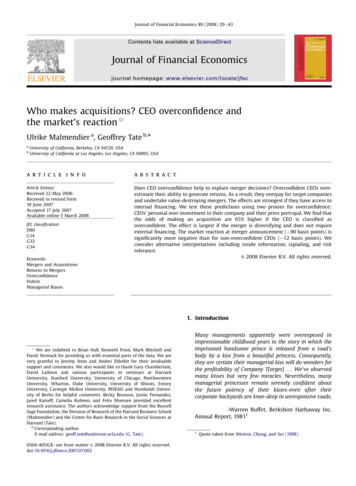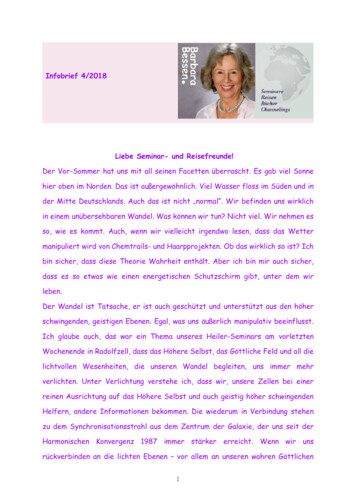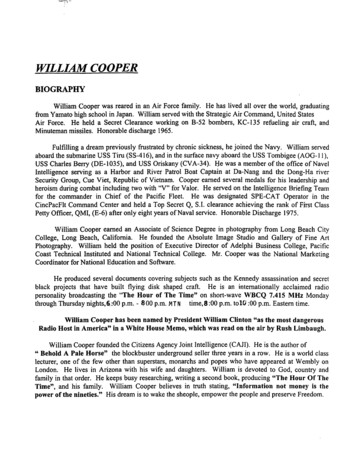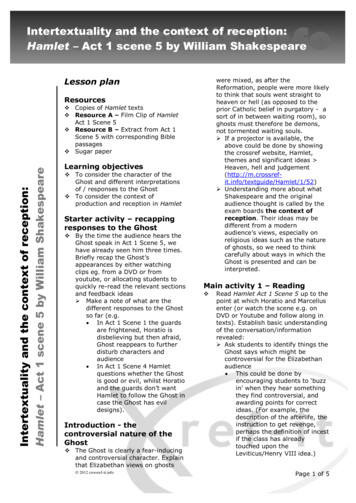
Transcription
ARTICLE IN PRESSJournal of Financial Economics 89 (2008) 20– 43Contents lists available at ScienceDirectVolume 88, Issue 1, April 2008ISSN 0304-405XManaging Editor:G. WILLIAM SCHWERTFounding Editor:MICHAEL C. JENSENAdvisory Editors:EUGENE F. FAMAKENNETH FRENCHWAYNE MIKKELSONJAY SHANKENANDREI SHLEIFERCLIFFORD W. SMITH, JR.RENÉ M. STULZJournal of Financial EconomicsJOURNAL OFFinancialECONOMICSAssociate Editors:HENDRIK BESSEMBINDERJOHN CAMPBELLHARRY DeANGELODARRELL DUFFIEBENJAMIN ESTYRICHARD GREENJARRAD HARFORDPAUL HEALYCHRISTOPHER JAMESSIMON JOHNSONSTEVEN KAPLANTIM LOUGHRANMICHELLE LOWRYKEVIN MURPHYMICAH OFFICERLUBOS PASTORNEIL PEARSONJAY RITTERRICHARD GREENRICHARD SLOANJEREMY C. STEINJERRY WARNERMICHAEL WEISBACHKAREN WRUCKjournal homepage: www.elsevier.com/locate/jfecPublished by ELSEVIERin collaboration with theWILLIAM E. SIMON GRADUATE SCHOOLOF BUSINESS ADMINISTRATION,UNIVERSITY OF ROCHESTERAvailable online at www.sciencedirect.comWho makes acquisitions? CEO overconfidence andthe market’s reaction Ulrike Malmendier a, Geoffrey Tate b, abUniversity of California, Berkeley, CA 94720, USAUniversity of California at Los Angeles, Los Angeles, CA 90095, USAa r t i c l e i n f oabstractArticle history:Received 22 May 2006Received in revised form18 June 2007Accepted 17 July 2007Available online 5 March 2008Does CEO overconfidence help to explain merger decisions? Overconfident CEOs overestimate their ability to generate returns. As a result, they overpay for target companiesand undertake value-destroying mergers. The effects are strongest if they have access tointernal financing. We test these predictions using two proxies for overconfidence:CEOs’ personal over-investment in their company and their press portrayal. We find thatthe odds of making an acquisition are 65% higher if the CEO is classified asoverconfident. The effect is largest if the merger is diversifying and does not requireexternal financing. The market reaction at merger announcement ( 90 basis points) issignificantly more negative than for non-overconfident CEOs ( 12 basis points). Weconsider alternative interpretations including inside information, signaling, and risktolerance.& 2008 Elsevier B.V. All rights reserved.JEL classification:D80G14G32G34Keywords:Mergers and AcquisitionsReturns to MergersOverconfidenceHubrisManagerial Biases1. Introduction We are indebted to Brian Hall, Kenneth Froot, Mark Mitchell andDavid Yermack for providing us with essential parts of the data. We arevery grateful to Jeremy Stein and Andrei Shleifer for their invaluablesupport and comments. We also would like to thank Gary Chamberlain,David Laibson and various participants in seminars at HarvardUniversity, Stanford University, University of Chicago, NorthwesternUniversity, Wharton, Duke University, University of Illinois, EmoryUniversity, Carnegie Mellon University, INSEAD and Humboldt University of Berlin for helpful comments. Becky Brunson, Justin Fernandez,Jared Katseff, Camelia Kuhnen, and Felix Momsen provided excellentresearch assistance. The authors acknowledge support from the RussellSage Foundation, the Division of Research of the Harvard Business School(Malmendier) and the Center for Basic Research in the Social Sciences atHarvard (Tate). Corresponding author.E-mail address: geoff.tate@anderson.ucla.edu (G. Tate).0304-405X/ - see front matter & 2008 Elsevier B.V. All rights reserved.doi:10.1016/j.jfineco.2007.07.002Many managements apparently were overexposed inimpressionable childhood years to the story in which theimprisoned handsome prince is released from a toad’sbody by a kiss from a beautiful princess. Consequently,they are certain their managerial kiss will do wonders forthe profitability of Company T[arget] . . . We’ve observedmany kisses but very few miracles. Nevertheless, manymanagerial princesses remain serenely confident aboutthe future potency of their kisses-even after theircorporate backyards are knee-deep in unresponsive toads.-Warren Buffet, Berkshire Hathaway Inc.Annual Report, 198111Quote taken from Weston, Chung, and Sui (1998).
ARTICLE IN PRESSU. Malmendier, G. Tate / Journal of Financial Economics 89 (2008) 20–43U.S. firms spent more than 3.4 trillion on over 12,000mergers during the last two decades. If chief executiveofficers (CEOs) act in the interest of their shareholders,these mergers should have increased shareholder wealth.Yet, acquiring shareholders lost over 220 billion at theannouncement of merger bids from 1980 to 2001(Moeller, Schlingemann, and Stulz, 2005). While the jointeffect of mergers on acquiror and target value may bepositive, acquiring shareholders appear to be on the losingend.2 In this paper, we ask whether CEO overconfidencehelps to explain the losses of acquirors.Overconfidence has long had popular appeal as anexplanation for failed mergers.3 Roll (1986) first formalized the notion, linking takeover contests to the winner’scurse. The implications of overconfidence for mergers,however, are more subtle than mere overbidding. Overconfident CEOs also overestimate the returns theygenerate internally and believe outside investors undervalue their companies. As a result, they are reluctant toraise external finance and may forgo mergers if externalcapital is required. The effect of overconfidence on mergerfrequency, then, is ambiguous. Overconfident managersare unambiguously more likely to conduct mergers only ifthey have sufficient internal resources. Moreover, if overconfidence increases merger frequency, it also lowersaverage deal quality and induces a lower average marketreaction to the announcement of merger bids.We test these hypotheses using a sample of 394 largeU.S. firms from 1980 to 1994. We use CEOs’ personalportfolio decisions to elicit their beliefs about theircompanies’ future performance. Previous literature showsthat risk averse CEOs should reduce their exposure tocompany-specific risk by exercising in-the-money executive stock options prior to expiration.4 A subset of CEOs inour data persistently fails to do so. They delay optionexercise all the way until expiration, even when theunderlying stock price exceeds rational exercise thresholds such as those derived in Hall and Murphy (2002).Moreover, they typically make losses from holding theiroptions relative to a diversification strategy.We link the beliefs CEOs reveal in their personalportfolio choices to their merger decisions. We find thatCEOs who fail to diversify their personal portfolios aresignificantly more likely to conduct mergers at any pointin time. The results hold when we identify such CEOs witha fixed-effect (‘‘Longholder’’) or allow for variation overtime (‘‘Post-Longholder’’ and ‘‘Holder 67’’). They arerobust to controlling for standard merger determinantslike Q , size, and cash flow, and using firm fixed effects to2Andrade, Mitchell, and Stafford (2001) find average stock pricereactions of 0:4 and 1:0% over a three-day window for acquirorsduring the 1980s and 1990s; see also Dodd (1980), Firth (1980), andRuback and Mikkelson (1984). Targets may gain from merger bids; seeAsquith (1983) and Bradley, Desai, and Kim (1983). Jensen and Ruback(1983) and Roll (1986) survey earlier studies.3Recent business press articles include CFO Magazine, June 1, 2004(‘‘Avoiding Decision Traps’’); US Newslink, December 13, 2001 (‘‘Enron’sBust: Was It the Result of Over-Confidence or a Confidence Game?’’);Accenture Outlook Journal, January, 2000 (‘‘Mergers & Acquisitions:Irreconcilable Differences’’).4See, e.g., Lambert, Larcker, and Verrecchia (1991).21remove the impact of time-invariant firm characteristics.The effect is largest among firms with abundant internalresources and for diversifying acquisitions. Taking diversification as a proxy for value destruction,5 these resultsconfirm the overconfidence hypothesis.We also analyze the market’s reaction to mergerannouncements, which provides a more direct measureof value creation. We find that investors react significantlymore negatively to merger bids of Longholder CEOs. Overthe three days around announcements, they lose onaverage 90 basis points, compared to 12 basis points forother CEOs. The result holds controlling for relatedness oftarget and acquiror, ownership stake of the acquiring CEO,board size of the acquiror, and method of financing. Whileannouncement effects may not capture the overall valuecreated by mergers, due to market frictions and inefficiencies (Shleifer and Vishny, 2003, Mitchell, Pulvino, andStafford, 2004), the differential reaction to bids of Longholder CEOs is likely to be orthogonal to these factors and,thus, to capture value differences.We consider several explanations for the link betweenlate option exercise and mergers: positive inside information, signaling, board pressure, risk tolerance, taxes, procrastination, and overconfidence. Only positive CEObeliefs (inside information or overconfidence) and riskpreferences (risk tolerance), however, provide a straightforward explanation for both personal overinvestmentand excessive merger activity. Among these explanationsinside information (or signaling) is hard to reconcile withthe losses CEOs incur on their personal portfolios bydelaying option exercise and with the more negativereaction to their merger bids. Similarly, risk seeking isdifficult to reconcile with the observed preference forcash financing and diversifying mergers. Overconfidence,instead, is consistent with all findings.To further test the overconfidence interpretation,we hand-collect data on CEO coverage in the businesspress. We identify CEOs characterized as ‘‘confident’’ or‘‘optimistic’’ versus ‘‘reliable,’’ ‘‘cautious,’’ ‘‘conservative,’’‘‘practical,’’ ‘‘frugal,’’ or ‘‘steady.’’ Characterization asconfident or optimistic is significantly positively correlated with our portfolio measures of optimistic beliefs.And, our main results replicate using a press-basedmeasure of overconfidence.Our results suggest that a significant subset of CEOs isoverconfident about their future cash flows and engagesin mergers that do not warrant the paid premium.Overconfidence may create firm value along some dimensions—for example, by counteracting risk aversion, inducing entrepreneurship, allowing firms to make crediblethreats, or attracting similarly-minded employees6—butmergers are not among them.5Graham, Lemmon, and Wolf (2002) and Villalonga (2004), amongothers, question the interpretation of the diversification discount andattribute the effect to pre-existing discounts or econometric and databiases. Schoar (2002), however, confirms the negative impact ofdiversification via acquisition using plant-level data.6See Bernardo and Welch (2001), Goel and Thakor (2000), Schelling(1960), and Van den Steen (2005).
ARTICLE IN PRESS22U. Malmendier, G. Tate / Journal of Financial Economics 89 (2008) 20–43Our paper relates to several strands of literature. First,we contribute to research on the explanations for mergers.Much of the literature focuses on the efficiency gains frommergers (e.g., Lang, Stulz, and Walkling, 1989; Servaes,1991; Mulherin and Poulsen, 1998). Overconfidence,instead, is closest to agency theory (Jensen, 1986; Jensen,1988). Empire-building, like overconfidence, predictsheightened acquisitiveness to the detriment of shareholders, especially given abundant internal resources(Harford, 1999). Unlike traditional empire-builders, however, overconfident CEOs believe that they are acting inthe interest of shareholders, and are willing to personallyinvest in their companies. Thus, while excessive acquisitiveness can result both from agency problems and fromoverconfidence, the relation to late option exercise, i.e.,CEOs’ personal overinvestment in their companies, arisesonly from overconfidence.The paper also contributes to the literature on overconfidence. Psychologists suggest that individuals areespecially overconfident about outcomes they believeare under their control (Langer, 1975; March and Shapira,1987) and to which they are highly committed (Weinstein,1980; Weinstein and Klein, 2002).7 Both criteria apply tomergers. The CEO gains control of the target. And asuccessful merger enhances professional standing andpersonal wealth.We also contribute to the growing strand of behavioralcorporate finance literature considering the consequencesof biased managers in efficient markets (Barberis andThaler, 2003; Baker, Ruback, and Wurgler, 2006; Camererand Malmendier, 2007). A number of recent papers studyupward biases in managers’ self-assessment, focusing oncorporate finance theory (Heaton, 2002), the decisionmaking of entrepreneurs (Landier and Thesmar, 2003), orindirect measures of ‘‘hubris’’ (Hayward and Hambrick,1997). We complement the literature by using thedecisions of CEOs in large companies to measure biasedmanagerial beliefs and their implications for mergerdecisions. Seyhun (1990) also considers insider stocktransactions around mergers, though overconfidence isnot his primary focus. Our approach is most similar toMalmendier and Tate (2005), but improves the identification and test of overconfidence in two important ways: bydirectly measuring the value consequences of corporatedecisions and by constructing an alternative media-basedproxy.The paper is organized as follows. Section 2 derives theempirical predictions of managerial overconfidence formergers. Section 3 introduces the data. Section 4 developsour empirical measures of delayed option exercise. Section5 describes the empirical strategy and relates late optionexercise to heightened acquisitiveness and more negative7The overestimation of future outcomes, as analyzed in thisliterature, is sometimes referred to as ‘‘optimism’’ rather than ‘‘overconfidence,’’ while ‘‘overconfidence’’ is used to denote the underestimation of confidence intervals. We follow the literature on self-servingattribution and choose the label ‘‘overconfidence’’ for the overestimationof outcomes related to own abilities (such as IQ or managerial skills) and‘‘optimism’’ for the overestimation of exogenous outcomes (such as thegrowth of the U.S. economy).market reactions to merger bids. Section 6 discussesalternative interpretations of the link between lateexercise and mergers and derives a press-based measureof overconfidence. Section 7 concludes.2. Empirical predictionsWe analyze the impact of overconfidence on mergersin a general setting that allows for market inefficiencies,such as information asymmetries, and managerial frictions, such as agency costs and private benefits.8 Weassume that these frictions and the quality of mergeropportunities do not vary systematically between overconfident and rational CEOs, i.e., that overconfident andrational CEOs sort randomly across firms over time. Whenwe test the resulting predictions, we account for violations of this assumption using a host of firm and managerlevel controls.Overconfident managers overestimate their ability tocreate value. As a result, they overestimate the returnsthey can generate both in their own company and bytaking over other firms. These two manifestations ofoverconfidence generate a trade-off when consideringpotential mergers. The overestimation of merger synergiesinduces excessive willingness to acquire other firms. But,the overestimation of stand-alone value generates perceived financing costs: potential lenders demand a higherinterest rate and potential new shareholders demandlower issuance prices than the CEO deems appropriategiven future returns. As a result, the CEO may forgo valuecreating mergers he perceives to be too costly to finance,even if investors evaluate the company and the mergercorrectly. Thus, the net effect of overconfidence on mergerfrequency is ambiguous. A positive net effect wouldindicate that overconfidence is an important explanationof merger activity in practice, but is not a necessaryimplication of overconfidence.Overconfidence unambiguously predicts more mergers, however, when the CEO does not need to accessexternal capital markets to finance the deal. In firms withlarge cash stocks or spare riskless debt capacity, onlythe overestimation of synergies impacts the mergerdecisions of overconfident CEOs. We obtain the followingprediction:Prediction 1. In firms with abundant internal resources,overconfident CEOs are more likely to conduct acquisitions than non-overconfident CEOs.Overconfidence also has implications for the valuecreated by mergers. Since overconfident managers overestimate merger synergies, they misperceive some mergeropportunities with negative synergies to be value-creating. As a result, they are more likely to undertake valuedestroying projects that rational managers would forgo.Moreover, overconfident managers may have too high areservation price for the target firm. Thus, if they compete8We derive these and further predictions formally in a more stylizedsetting in Malmendier and Tate (2004).
ARTICLE IN PRESSU. Malmendier, G. Tate / Journal of Financial Economics 89 (2008) 20–43with another bidder or if the target has significantbargaining power, they may overpay.9Overconfident CEOs may also forgo some value-creating mergers due to perceived financing costs. Abstainingfrom a value-creating deal lowers shareholder value(though it improves average deal quality if the forgonedeal is below average). Hence, we have the followingprediction:Prediction 2. If overconfident CEOs do more mergersthan rational CEOs, then the average value created inmergers is lower for overconfident than for rational CEOs.Note that overconfidence does not necessarily predict anegative reaction to merger bids. Rational managers maydo some value-destroying deals or forgo some valuecreating deals due to other frictions. In the latter case,some of the extra mergers of overconfident CEOs maycreate value (as in Goel and Thakor, 2000). However, aslong as overconfident CEOs undertake more mergers, theaverage announcement effect for bids by overconfidentCEOs will be lower than the average announcement effectamong rational CEOs.3. DataOur starting sample consists of 477 large publiclytraded U.S. firms from 1980 to 1994. The core of the dataset is described in detail in Hall and Liebman (1998) andYermack (1995). To be included in the sample, a firm mustappear at least four times on one of the Forbes magazinelists of largest U.S. companies from 1984 to 1994.10 Thevirtue of this data set is its detailed information on CEOsstock and option holdings. We observe, in each sampleyear, the number of remaining options from the grants theCEO received in each of his prior years in office as well asthe remaining duration and strike price. The data providea fairly detailed picture of the CEO’s portfolio rebalancingover his tenure.We also collect data on articles about the CEOs in TheNew York Times, BusinessWeek, Financial Times, and TheEconomist using LexisNexis and in the The Wall StreetJournal using Factiva.com. For each CEO and sample year,we record (1) the total number of articles, (2) the numberof articles containing the words ‘‘confident’’ or ‘‘confidence,’’ (3) the number of articles using ‘‘optimistic’’ or‘‘optimism,’’ (4) the number of articles using ‘‘reliable,’’‘‘cautious,’’ ‘‘conservative,’’ ‘‘practical,’’ ‘‘frugal,’’ or ‘‘steady.’’ We hand-check that the terms describe the CEO andseparate out articles in which ‘‘confident’’ or ‘‘optimistic’’are negated.119Note that, contrary to Roll’s (1986) theory, an overconfident CEOdoes not always bid higher than a rational bidder. A CEO who is moreoverconfident about the value of his firm than about the merger may losethe contest due to perceived financing costs.10This criterion excludes IPOs from our sample. Thus, the morestringent restrictions on trading associated with such firms, such aslockup periods, do not apply.11Our search procedure also ensures that the words ‘‘overconfidence,’’ ‘‘overconfident,’’ ‘‘overoptimistic,’’ and ‘‘overoptimism’’ (with orwithout hyphenation) will show up in categories (2) and (3).23We use the Securities Data Company (SDC) and Centerfor Research in Security Prices (CRSP) merger databases toobtain announcement dates and merger financing information for completed deals by our sample firms. The CRSPdata set covers only mergers with CRSP-listed targets. Weuse SDC to supplement the data with acquisitions ofprivate firms, large subsidiaries, and foreign companies.12We require that the acquiring company obtains at least51% of the target shares (and, hence, control) and omitacquisitions in which the acquiror already holds at least51% of the target before the deal. Finally, following Morck,Shleifer, and Vishny (1990), we omit acquisitions worthless than 5% of acquiror value.13We supplement the data with various items from theCompustat database. We measure firm size as the naturallogarithm of assets (item 6) at the beginning of the year,investment as capital expenditures (item 128), cash flowas earnings before extraordinary items (item 18) plusdepreciation (item 14), and capital as property, plants andequipment (item 8). We normalize cash flow by beginning-of-the-year capital. Given that our sample is notlimited to manufacturing firms (though it mainly consistsof large, non-financial firms), we check the robustness ofour results to normalization by assets (item 6). Wemeasure Q as the ratio of market value of assets to bookvalue of assets. Market value of assets is defined as totalassets (item 6) plus market equity minus book equity.Market equity is defined as common shares outstanding(item 25) times fiscal year closing price (item 199). Bookequity is calculated as stockholders’ equity (item 216) [orthe first available of common equity (item 60) pluspreferred stock par value (item 130) or total assets (item6) minus total liabilities (item 181)] minus preferred stockliquidating value (item 10) [or the first available ofredemption value (item 56) or par value (item 130)] plusbalance sheet deferred taxes and investment tax credit(item 35) when available minus post retirement assets(item 330) when available. Book value of assets is totalassets (item 6).14 We use fiscal year closing prices (item199) adjusted for stock splits (item 27) to calculate annualstock returns. Our calculation of annual returns excludesdividends; we consider the impact of capital appreciationand dividend payments separately in Section 6. We useCRSP to gather stock prices and Standard IndustrialClassification (SIC) codes. Missing accounting data (largelyof financial firms) leaves us with a final sample of 394firms. As in Malmendier and Tate (2005), we trim cashflow at the 1% level to ensure that our results are notdriven by outliers. However, all results replicate with thefull data.In addition, we collect personal information about theCEOs using Dun and Bradstreet (1997) and Who’s Who inFinance and Industry (1980/81–1995/96). We broadly12All results are robust to using only CRSP data, i.e., mergersinvolving publicly traded U.S. targets.13This criterion is important when using SDC data since acquisitionsof small units of another company differ substantially from those of largeNYSE firms and may not require active involvement of the acquiror’sCEO.14Definitions of Q and its components as in Fama and French (2002).
ARTICLE IN PRESS24U. Malmendier, G. Tate / Journal of Financial Economics 89 (2008) 20–43classify a CEO’s educational background as financial,technical, or miscellaneous. CEOs have finance educationif they hold undergraduate or graduate degrees inaccounting, finance, business (including an MBA), oreconomics. They have technical education if they holdundergraduate or graduate degrees in engineering, physics, operations research, chemistry, mathematics, biology,pharmacy, or other applied sciences.Table 1 presents summary statistics of the data. PanelA presents firm-specific variables. Our sample firms arelarge, and most (48%) are in the manufacturing industry.Panel B shows CEO-specific variables, both for the full setof CEOs and for the subset of CEOs whom we classify asoverconfident based on their option-exercise behavior(‘‘Longholder,’’ see Section 4). The means, medians andstandard deviations of all variables are remarkably similarfor Longholder and non-Longholder CEOs. Only thenumber of vested options that have not been exercisedis considerably higher among Longholder CEOs. Thisdifference could stem from overconfidence, as we willsee later. But, regardless, we will control for the level ofvested options in all of our regressions. Panel C presentsthe summary statistics of the CEOs’ press coverage. Whilethe mean and median number of annual mentions arerelatively high (8.89 and 3), mentions with the attributes‘‘confident’’ or ‘‘optimistic’’ or any of ‘‘reliable,’’ ‘‘cautious,’’‘‘conservative,’’ ‘‘practical,’’ ‘‘steady,’’ and ‘‘frugal’’ areinfrequent (the means are below 0.1 and the mediansare 0). Our analysis will use dummy variables, whichindicate differences in the number of mentions of eachtype, in lieu of the raw numbers of articles in eachcategory. Finally, Panel D presents summary statisticsof the mergers undertaken by CEOs in our sample.Notably, the acquiror’s stock has a negative cumulativeabnormal return of 29 basis points on average over thethree day window surrounding the announcement of amerger bid.4. Measuring overconfidenceWe use the panel data on CEOs’ personal portfolios toidentify differences across managers in executive optionexercise. Executive options give the holder the right topurchase company stock, usually at the stock price on thegrant date. Most executive options have a ten-year lifespan and are fully exercisable after a four-year vestingperiod. Upon exercise, the holder receives shares ofcompany stock. These shares are almost always immediately sold (Ofek and Yermack, 2000).Merton (1973) shows that investors should notexercise options early since the right to delay purchasingthe underlying stock has non-negative value and investorsare free to diversify. This logic does not apply to executiveoptions. Executive options are non-tradeable, and CEOscannot hedge (legally) the risk of their holdings by shortselling company stock. CEOs are also highly exposed tocompany risk since a large part of their compensation isequity-based and their human capital is invested in theirfirms. As a result, risk-averse CEOs should exercise optionsearly if the stock price is sufficiently high (Lambert,Larcker, and Verrecchia, 1991; Hall and Murphy, 2002), i.e.,when the marginal cost of continuing to hold the option(risk exposure) exceeds the marginal benefit (optionvalue). The exact threshold for exercise depends onremaining option duration, individual wealth, the degreeof underdiversification, and risk aversion.In our sample of FORBES 500 CEOs, the high degree ofunderdiversification implies fairly low thresholds, givenreasonable calibrations of wealth and risk aversion.A subset of CEOs, however, persistently fails to exercisehighly in-the-money vested options. One interpretation ofthis failure to exercise is overconfidence, i.e., overestimation of the firm’s future returns. Other interpretationsinclude positive inside information, signaling, boardpressure, risk tolerance, taxes, and procrastination. Afterrelating late option exercise to merger decisions(Section 5), we will discuss these alternative interpretations (Section 6.1).We construct three indicator variables, which partitionour CEOs into ‘‘late’’ and ‘‘timely’’ option exercisers:Longholder: Our first indicator variable identifies CEOswho, at least once during their tenure, hold an option untilthe year of expiration, even though the option is at least40% in-the-money entering its final year. The exercisethreshold of 40% is calibrated using the model of Hall andMurphy (2002) with a constant relative risk aversion(CRRA) of three and 67% of wealth in company stock, andrefines the Longholder measure in Malmendier and Tate(2005). The particular choice of parameter values is notimportant for our results: the median percentage in-themoney entering the final year for options held toexpiration is 253. Any assumption from no threshold atall to a threshold of 100% yields similar results.15 We applythis measure as a managerial fixed effect, denoted Longholder.We construct two alternative indicators of late exercisewhich (1) allow for time variation over a manager’ssample years and (2) eliminate forward-looking information from the classification.Pre-/Post-Longholder: First, we split the Longholderindicator into two separate dummy variables. Post-Longholder is equal to 1 only after the CEO for the first timeholds an option until expiration (provided it exceeds the40% threshold). Pre-Longholder is equal to 1 for the rest ofthe CEO years in which Longholder is equal to 1.One shortcoming of Post-Longholder is its lack ofpower. Only 42% of the observations in which Longholderis 1 fall into the Post-Longholder category, capturing 74mergers. This effectively excludes the Post-Longholdermeasure from tests that require us to subdivide mergersinto finer categories (cash versus stock or diversifyingversus intra-industry mergers).Holder 67: We construct a second backward-lookingmeasure, Holder 67, which relaxes the requirement that15See Fig. 1 in the NBER Working Paper version, Malmendier andTate (2004). We do not calculate a separate threshold for every optionpackage, depending on the CEO’s wealth, diversification, and riskaversion, as we cannot observe these characteristics. Individual calibration would introduce observation-specific noise into the estimationwithout clear benefits.
ARTICLE IN PRESSU. Malmendier, G. Tate / Journal of Financial Economics 89 (2008) 20–4325Table 1Summary statisticsFinancial variables are reported in m. Q is the market value of assets over the book value of assets. Cash flow is earnings before extraordinary itemsplus depreciation. Stock ownership is the fraction of company stock owned by the CEO and his immediate family. Vested options are the CEO’s holdings ofoptions that are exercisable within six months, as a fraction of common shares outstanding, and multiplied by ten (so that the mean is roughlycomparable to Stock ownership). Efficient board
David Yermack for providing us with essential parts of the data. We are very grateful to Jeremy Stein and Andrei Shleifer for their invaluable support and comments. We also would like to thank Gary Chamberlain, David Laibson and various participants in seminars at Harvard University, Stanford University, University of Chicago, Northwestern










